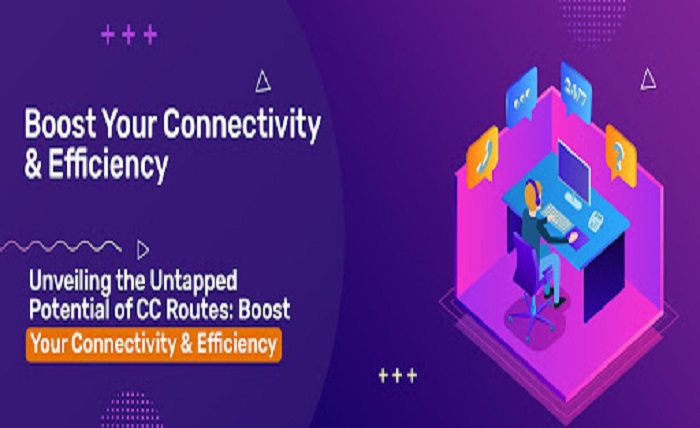My Country Mobile: Overview of Call Center Routing Systems and Features

Definition of CC Routes
CC Routes, also known as Call Center Routes, refer to the pathways through which voice calls are directed in the telecommunications industry. They establish connections between callers and call center agents.
Essentially, CC Routes act as a bridge that enables smooth communication between customers and call centers. These routes facilitate the efficient routing of incoming and outgoing calls, ensuring that they reach the appropriate agents or destinations.
CC Routes are typically implemented using Voice over Internet Protocol (VoIP) technology, which leverages internet connections to transmit voice data. This allows for cost-effective telecommunication solutions with enhanced features such as call recording, real-time analytics, and interactive voice response systems.
Importance and relevance of CC Routes in the telecommunications industry
The telecommunications industry constantly evolves to meet the growing demands of businesses worldwide. Within this dynamic landscape, CC Routes play a pivotal role in ensuring seamless customer interactions while maximizing efficiency for call center operations. One major significance of CC Routes lies in optimizing call management processes.
By intelligently directing incoming calls to available agents using advanced routing algorithms, these routes reduce wait times for customers and improve overall customer satisfaction levels. Moreover, outbound CC Routes aid businesses in making targeted sales calls or conducting market research surveys efficiently.
Furthermore, CC Routes enable companies to streamline their workforce by assigning specific skill-based routing algorithms that connect customers with agents who possess relevant expertise. This ensures that every customer query is resolved by a qualified agent swiftly and effectively.
In addition to enhancing customer experience and agent productivity, CC Routes provide valuable insights through real-time analytics dashboards. These dashboards offer comprehensive data about call volume patterns, average handling times (AHT), agent performance metrics like first-call resolution rates (FCR), enabling managers to identify bottlenecks or areas for improvement within their call centers.
Overall, implementing effective CC Route strategies not only drives operational efficiency but also enhances brand reputation by delivering exceptional customer service experiences. In today’s highly competitive business landscape, organizations that prioritize seamless communication and efficient call center management will undoubtedly gain a significant competitive edge.
Overview of CC Routes
Explanation of the term “CC” (Call Center)
A call center, often referred to as a CC, is a centralized office or facility where a large volume of telephone calls are handled by customer service representatives. These representatives, also known as agents, are responsible for providing assistance, addressing inquiries, and resolving customer issues. The term “CC” has become synonymous with the concept of call centers worldwide.
Brief history and evolution of CC Routes
The emergence of call centers in the mid-20th century marked a significant shift in business communication practices. Initially, organizations relied on simple telephone operators to handle incoming calls manually.
However, as businesses grew and customer demands increased, there arose a need for more efficient telephonic systems. In the 1950s and 1960s, automated private branch exchanges (PBX) started to gain popularity.
PBX systems enabled companies to manage incoming calls more effectively by routing them to specific departments or individuals within the organization. This innovation laid the foundation for modern call center operations.
Advancements in technology during the late 20th century further revolutionized call center capabilities. The integration of computer systems with telephony led to the development of computer-telephony integration (CTI).
CTI allowed for greater automation and streamlining of call center processes. With the advent of Voice over IP (VoIP) technology in the 1990s and early 2000s, CC routes underwent another transformation.
Instead of traditional landline connections, VoIP enabled voice traffic to be transmitted over internet networks using packet-switching techniques. This innovation not only reduced costs but also facilitated more flexible and scalable CC routing solutions.
Today, CC routes VOIP continue to evolve with advancements such as cloud-based contact center solutions that offer enhanced scalability, global accessibility, and advanced features like real-time analytics and artificial intelligence integration. These developments have significantly improved the efficiency and effectiveness of call center operations, empowering organizations to provide exceptional customer service experiences.
Overall, the history and evolution of CC routes reflect the continuous pursuit of improving customer interactions through technological innovations. From manual telephone systems to sophisticated computer-telephony integrations and VoIP technologies, call center routing has come a long way in enhancing communication efficiency and customer satisfaction.
Functionality and Components of CC Routes
Call Routing Algorithms
CC routes, also known as Call Center routes, are an integral part of the telecommunications industry. They play a vital role in efficiently managing CC traffic and directing calls to the appropriate agents. The functionality of CC routes relies on sophisticated call routing algorithms that determine how incoming calls are distributed among available agents.
These algorithms ensure fair distribution, optimal resource allocation, and enhance the overall customer experience. One commonly used call routing algorithm is the Round Robin Algorithm.
This algorithm assigns incoming calls in a cyclical manner to available agents. Each agent receives an equal number of calls before moving on to the next agent in line.
This method ensures that each agent has a fair workload and prevents some agents from being overwhelmed while others remain idle. Another popular algorithm is the Least Occupied Agent Algorithm.
As the name suggests, this algorithm assigns incoming calls to agents based on their current workload. It constantly monitors agent availability and assigns calls to those with the least ongoing conversations or pending tasks.
By distributing calls evenly across all available resources, this algorithm optimizes efficiency and reduces wait times for customers. Skill-Based Routing Algorithm takes call routing a step further by considering not only agent availability but also their specific skills and expertise.
This intelligent algorithm matches callers with agents who possess the necessary knowledge or language proficiency required for a particular inquiry or service request. Skill-Based Routing ensures that customers are connected with competent agents who can promptly address their needs, resulting in enhanced customer satisfaction.
Interactive Voice Response (IVR) Systems
Within CC routes, Interactive Voice Response (IVR) systems play an essential role in streamlining customer interactions before they reach a live agent. IVR systems use automated menus to interact with callers and gather information about their needs through voice commands or keypad inputs.
The purpose of IVR systems in CC routes is twofold. Firstly, they provide customers with a self-service option, allowing them to navigate through pre-recorded menu options to get the information they need or perform basic tasks such as bill payments or appointment scheduling.
This reduces the workload on agents and shortens waiting times for callers. Secondly, IVR systems act as intelligent call filters, collecting relevant information from callers and intelligently routing them to the most appropriate department or agent.
By capturing caller inputs and analyzing predetermined criteria such as language preference or service type required, IVR systems ensure that customers are efficiently routed to the right agent, saving time for both parties involved. IVR systems also offer a range of customization options to meet the specific needs of CC routes.
These include personalized greetings, configurable voice prompts, and integration with customer databases for personalized interactions. Additionally, IVR systems can be programmed to provide real-time updates on wait times or queue positions so that customers are well-informed about their expected waiting period.
The functionality of CC routes heavily relies on advanced call routing algorithms and interactive voice response (IVR) systems. Call routing algorithms such as Round Robin Algorithm, Least Occupied Agent Algorithm, and Skill-Based Routing Algorithm ensure fair distribution of calls among agents while considering their workload and skills.
IVR systems enable self-service options for customers while intelligently directing calls based on caller inputs and predefined criteria. The combination of these components enhances efficiency in handling CC traffic and improves overall customer satisfaction in telecommunications industries.
Inbound CC Routes
Definition and Characteristics
Inbound CC Routes refer to the process of routing incoming calls to call centers or customer service representatives. These routes are designed to efficiently handle customer inquiries, complaints, or requests for assistance.
The main objective of inbound CC routes is to ensure that each call is directed to the most appropriate agent with the necessary skills and knowledge to address the caller’s needs effectively. Characteristics of inbound CC routes include intelligent call routing mechanisms, which analyze various factors such as caller identity, geographical location, language preferences, and previous interaction history.
By considering these parameters, inbound CC routes can determine the most suitable agent or department to handle the specific query. Additionally, inbound CC routes often incorporate interactive voice response (IVR) systems that greet callers with pre-recorded messages and provide self-service options before connecting them with a live agent if needed.
Examples of Industries Utilizing Inbound CC Routes
Numerous industries extensively rely on inbound CC routes to manage their customer interactions effectively. One prominent sector utilizing these routes is customer support services. Companies in industries such as telecommunications, e-commerce, banking, and healthcare employ inbound CC routes for customers seeking assistance in billing inquiries, product information, or technical support.
Technical assistance providers also make use of inbound CC routes by utilizing specialized agents who possess advanced knowledge in troubleshooting software applications and hardware devices. These agents skillfully navigate through complex issues raised by customers and provide timely solutions.
Moreover, reservation centers in the travel industry leverage inbound CC routes for handling bookings made over phone calls. Customers seeking flight reservations, hotel accommodations, or car rentals can easily connect with dedicated agents who are well-versed in serving their specific needs.
Outbound CC Routes
Definition and Characteristics
Outbound CC Routes involve placing outgoing calls from a call center to external parties, such as potential customers or existing clients. The primary purpose of outbound CC routes is to initiate proactive communication for various objectives, including telemarketing, sales, lead generation, and market research.
Outbound CC routes employ predictive dialing algorithms to maximize agent productivity by automatically dialing multiple numbers simultaneously and connecting agents only when a call is answered by a person. This ensures that agents spend most of their time actively engaging with customers rather than navigating through busy tones or voicemails.
Examples of Industries Utilizing Outbound CC Routes
The telemarketing industry heavily relies on outbound CC routes to reach out to potential customers and promote products or services. Telemarketers can efficiently manage high call volumes through automated dialing systems that connect them with prospects in a timely manner. Sales-focused organizations also utilize outbound CC routes to engage with leads generated through marketing campaigns, allowing their sales representatives to establish personal connections and convert prospects into paying customers.
Market research firms often employ outbound CC routes to conduct surveys or gather feedback from targeted demographics. By utilizing these routes, they can efficiently contact individuals selected for participation in studies and collect the necessary data.
Inbound and outbound CC routes play crucial roles in managing customer interactions and facilitating proactive communication strategies. Inbound CC routes ensure that callers are connected with the most appropriate agents or departments who possess the necessary expertise for addressing their queries effectively.
On the other hand, outbound CC routes enable organizations to proactively reach out to prospects and clients for marketing purposes or gathering valuable insights. By utilizing these distinct types of CC routes effectively, businesses can enhance customer satisfaction levels, streamline operations, and drive revenue growth.
Advanced Features in CC Route Management Systems
Call Recording and Monitoring Tools
Unlocking the Potential of Accountability and Quality Assurance In the realm of call center management, call recording and monitoring tools play a pivotal role in ensuring accountability, enhancing quality assurance, and fostering continuous improvement.
These tools allow supervisors to record and review conversations between agents and customers for various purposes, including training, compliance adherence, dispute resolution, and performance evaluation. One of the primary purposes of call recording is to facilitate agent training.
By meticulously analyzing recorded calls, supervisors can identify areas where agents excel or struggle. This insight enables targeted coaching sessions aimed at improving customer interactions.
Additionally, call recordings act as valuable resources for new recruits who can learn from exemplary interactions with customers. Call recording technologies come in two distinct forms: cloud-based and on-premises solutions.
Cloud-based systems offer scalability, flexibility, and cost-efficiency by storing recordings securely in off-site servers accessible from anywhere with an internet connection. On the other hand, organizations seeking a higher level of control over their data may opt for on-premises solutions that store recordings locally within their own infrastructure.
Real-Time Analytics Dashboard
Illuminating Insights for Informed Decision-Making In today’s fast-paced business landscape, real-time analytics dashboards have emerged as indispensable tools for call center management. These comprehensive dashboards provide instant access to crucial performance indicators that help supervisors make informed decisions dynamically.
The importance of tracking key performance indicators (KPIs) cannot be overstated when striving to optimize CC routes VOIP efficiency. Real-time analytics dashboards empower managers to monitor various metrics such as agent occupancy rates, average handle time (AHT), call abandonment rates, and customer satisfaction scores.
With a multitude of features at their fingertips – ranging from agent performance metrics to call volume analysis – supervisors gain real-time visibility into the health of CC traffic. Armed with this knowledge, they can swiftly identify bottlenecks, address emerging issues, and make data-driven decisions to improve overall performance.
Real-time analytics dashboards also facilitate proactive decision-making. For instance, if call volumes spike unexpectedly, supervisors can promptly allocate additional resources to prevent excessive wait times or dissatisfied customers.
By acting in real-time based on comprehensive data analysis, organizations can achieve a competitive edge in delivering exceptional customer experiences. Call recording and monitoring tools as well as real-time analytics dashboards are advanced features within CC route management systems that revolutionize the way call centers operate.
By utilizing these tools effectively, organizations can ensure accountability and quality assurance while gaining invaluable insights for making informed decisions. Whether through analyzing recorded calls or tracking key performance indicators in real-time, these features empower call center managers to optimize their operations and deliver exceptional customer service.
Security Measures in CC Routes
Secure Data Transmission
CC routes involve the transmission of sensitive customer information, making it imperative to implement robust security measures. Encryption protocols such as Transport Layer Security (TLS) or Secure Real-Time Transport Protocol (SRTP) are commonly employed to protect the confidentiality and integrity of data during transmission. By encrypting the communication between agents, callers, and CC servers, unauthorized parties are prevented from intercepting or tampering with the information exchanged.
Authentication and Access Control
To ensure that only authorized personnel have access to CC routes and related systems, strong authentication mechanisms should be implemented. Multi-factor authentication (MFA) methods such as biometric recognition, smart cards, or tokens add an extra layer of security by requiring users to provide multiple proofs of identity. Additionally, access control policies should be established to grant appropriate privileges based on roles and responsibilities within the call center environment.
Vulnerability Assessments and Penetration Testing
Regular vulnerability assessments and penetration testing are essential for identifying potential weaknesses in CC route infrastructure. These proactive measures involve simulating real-world attacks on systems to evaluate their resilience against various threats.
By conducting such assessments regularly, call centers can actively identify vulnerabilities before malicious actors exploit them. This allows for timely implementation of necessary patches or security enhancements to protect against potential breaches.
Monitoring and Incident Response
An effective security strategy includes continuous monitoring of CC traffic for any suspicious activities or anomalies. Intrusion detection systems (IDS) and intrusion prevention systems (IPS) can automatically detect unauthorized access attempts or unusual patterns in network traffic, alerting administrators promptly. In addition, establishing an incident response team equipped with incident response plans ensures a swift reaction to any security incidents that may occur within the CC route infrastructure.
Conclusion
Implementing robust security measures in CC routes is vital to ensure the protection of sensitive data and maintain the trust of customers. By employing secure data transmission protocols, strong authentication mechanisms, conducting regular vulnerability assessments and penetration testing, and establishing monitoring systems alongside incident response teams, call centers can significantly reduce the risk of security breaches.
With these measures in place, not only can CC routes operate smoothly and efficiently, but customers can have peace of mind knowing that their confidential information is handled with utmost care. Embracing a proactive approach to security not only safeguards call center operations but also fosters a sense of confidence among both clients and agents alike.




